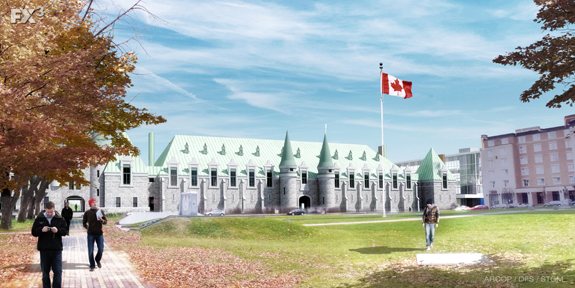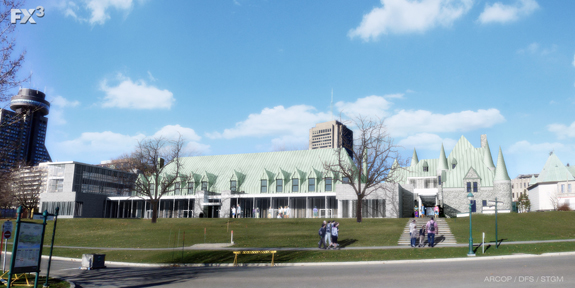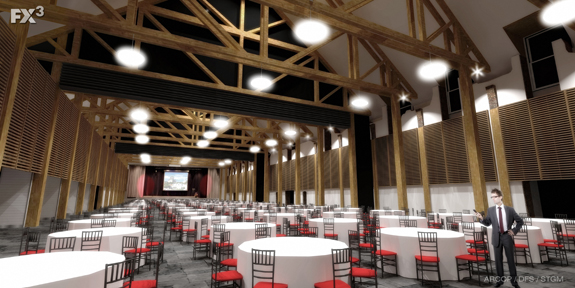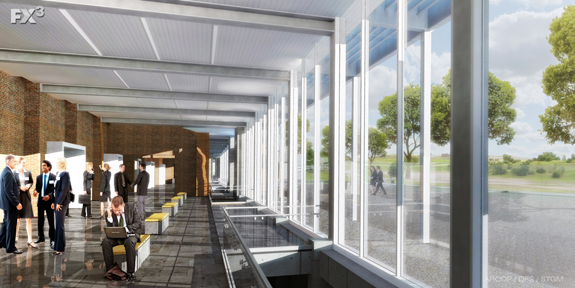Design for reconstruction of the Armoury announced in November 2012
Overview of the architectural design
The reconstructed Armoury will be a multi-purpose building which will include areas commemorating its military history, federal government offices and multi-purpose spaces for community, cultural and social activities. The Armoury will be rebuilt according to current standards, will be able to accommodate events involving up to 1,300 people in the public spaces available for rent, and will house areas commemorating the military history of the Armoury and the Régiment des Voltigeurs.
About half of the building will be used by the public, mainly for activities held in a large multi-purpose hall, while the other half will consist of administrative space for federal organizations and technical space.
The Armoury will have the same outward appearance as before the fire, particularly the facade (seen from Place George V and Grande Allée). From the rear (seen from the Plains side), the pre-fire Armoury will be recognizable by its roof. The stone walls, turrets and the east wing, including fenestration, will be among the elements restored to resemble the building as it was before. Consideration will also be given to the richness of the exterior elevations, marked by a strongly detailed stone base, the asymmetrical arrangement of turrets and buttresses, elaborate gable pediments and steeply pitched roofs decorated with ventilators and ridge cresting. The building will be expanded by adding volume on the west side and on the south side (behind the building, near the Plains) in order to optimize the facilities and make them more useful to both the community and the government.

Selected concept - Front view from the Grande Allée
Sketch not definitive -
Source: Arcop/DFS/STGM architectes en consortium

Selected concept - Rear view from the Plains of Abraham
Sketch not definitive -
Source: Arcop/DFS/STGM architectes en consortium
Further to these specialized analyses and evaluations, PWGSC recommended the adoption of the design that provided the best approach to protecting heritage and historical designations and respecting architectural integrity, while providing facilities that had the least impact on the building’s heritage character.
Click here to view the concepts that were not retained.
Halls, multi-purpose rooms and other interior features
All the space in the central building, which was the drill hall before the fire, will become a large multi-purpose space which could be used for community, cultural and social activities. The dimensions and the height of this room will be as before the fire. About 1,900m2 in area, it will be able to accommodate about 1,300 people, be divided into two or three sections according to needs, and will include a moveable stage. The design of this room will involve state-of-the-art technology and special attention will be given to the quality of the acoustics, since it will be used to stage events.

Selected concept - Overview of possible interior of multi-purpose room
Sketch not definitive -
Source: Arcop/DFS/STGM architectes en consortium
In addition, the Armoury will include a foyer adjoining the main room, two other, smaller, multi-purpose rooms, a reception room, a commemorative room, cloakrooms, a kitchen, public washrooms and technical service rooms.

Selected concept - Overview of possible interior of entry hall
Sketch not definitive -
Source: Arcop/DFS/STGM architectes en consortium
To encourage the maintenance of heritage designations, optimize the facilities and make them more useful for both the community and the government, the Armoury will be expanded through the construction of a new volume adjoining the existing building.
Visit the Web site of STGM architectes (available in French only) (a member of Arcop/DFS/STGM archites en consortium that developed the concepts) to view a 3D animation of the selected concept.
Links to the Plains of Abraham and underground parking
The proximity of the Plains of Abraham is one of the Armoury’s assets. The land will be partially redeveloped to create green space and make it easier to move between Place George V and the Plains of Abraham.
About 100 underground parking spaces will be built behind the Armoury, on the Plains of Abraham side. On top of the underground parking garage, a plaza will be constructed, with a garden commemorating the Régiment des Voltigeurs.
A reconstruction that respects heritage, architectural integrity and the environment
The architectural design encourages the protection of heritage and respect for architectural integrity to the greatest possible extent and is based on the drawings made in 1885 by Eugène-Étienne Taché, the architect of the original building. The remaining original components of the Armoury will be preserved and integrated into the building. However, the overall authenticity of 1887 and 1913 was lost in the 2008 fire, and, even if the choice had been made to opt for a complete restoration, identical to the original building, this authenticity could not have been regained. In addition, an identical reconstruction would not have complied with current legislation and codes.
All of the work and architectural elements will be designed to comply with internationally recognized methods for the preservation of built heritage, including standards and guidelines for the conservation of heritage sites in Canada. In accordance with these standards, the new elements, that is, those which did not exist before the fire, such as the addition to the Armoury where the federal offices will be located, will not be based on the existing architecture and will be identifiable as contemporary elements.
Heritage and architecture experts from PWGSC, Parks Canada and the Federal Heritage Buildings Review Office (FHBRO) were consulted during the design phase and will continue to be consulted throughout the project. The design is in line with the preferences expressed by the public during the public consultations in the spring of 2009, as well as with the recommendations of a specialized real property firm, which were public access to the site, respect for the historic and commemorative role of the site and the military presence and the protection of architectural heritage.
The Armoury project will comply with the government’s commitment to reduce its ecological footprint and meet the applicable environmental standards. The entire project will be designed to minimize overall cost and maximize energy performance, and will comply with high standards in terms of the sustainability of components and the longevity of construction.
